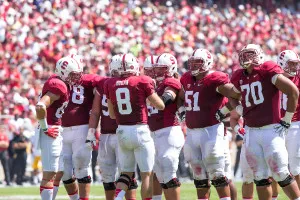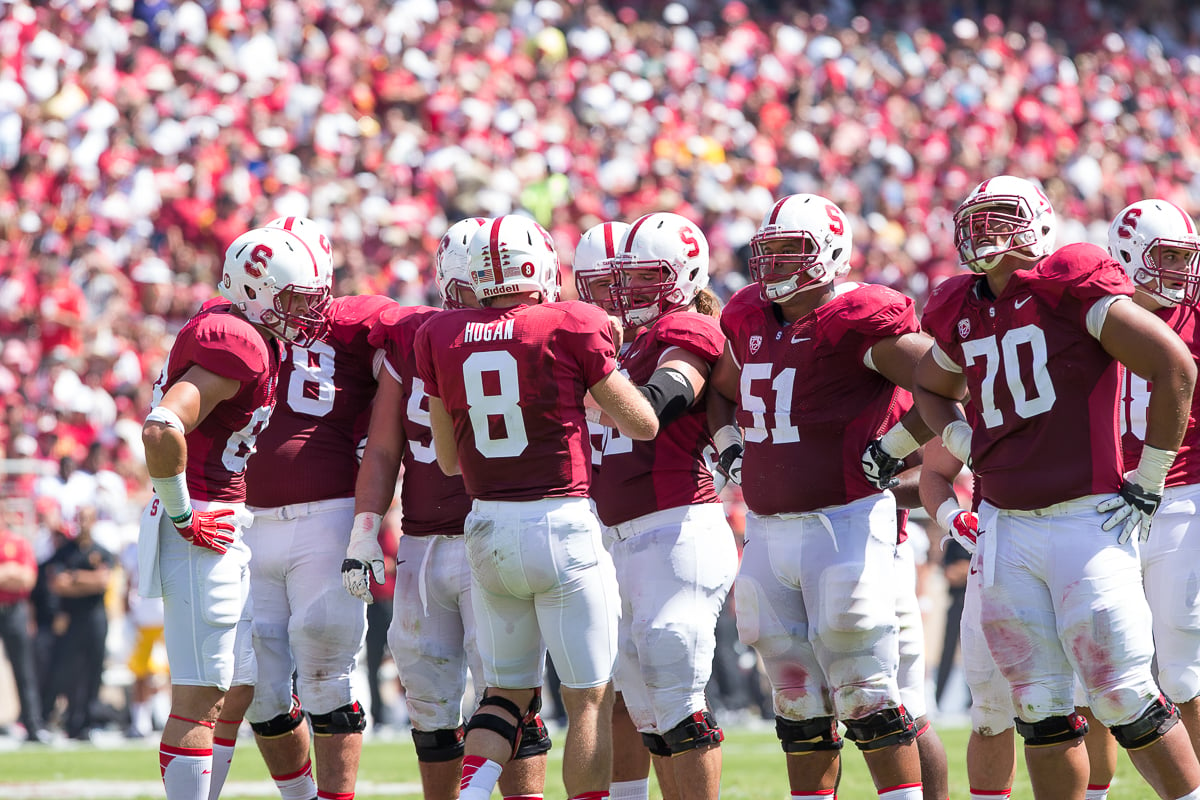Stanford’s offensive line struggled last Saturday against USC — the team averaged only 3.4 yards per rush, Kevin Hogan was drilled by an unmarked rusher on Stanford’s final offensive play, several costly penalties (also indirectly including a chipping penalty by running back Remound Wright, which was largely caused by a missed block by Josh Garnett) resulted in empty red-zone trips and multiple fumbled snaps nearly brought about turnovers. With four new starters on the offensive line, the unit clearly needed time to gel at the start of the season, even though it is widely believed to be one of the most talented lines in Stanford history. However, after Saturday’s display, we asked football writers Vihan Lakshman, Joseph Beyda and Do-Hyoung Park, is the offensive line really as good as it has been made out to be?
Vihan: Whoa, whoa, whoa. Let’s take a step back for a second and put the offensive line’s performance into context. With four new starters up front, we knew that it was going to take some time for this unit to communicate effectively and they just had to line up against one of the best defensive lines they will see all season in the second week.

There’s no doubt that the Tunnel Workers’ Union would like to have that performance back, but I think most of the issues we saw stem from a lack of communication and experience than any major deficiencies in talent. The penalties and the failed blitz pickup on the Stanford’s final offensive play were largely mental mistakes and should improve over time under the watch of Coach Bloomgren.
The Cardinal, however, did look unable to run power on Saturday and that’s truly alarming, especially considering that UC-Davis also had some success stopping the run. Nevertheless, it’s still too early to question the talent of this group. Junior Andrus Peat is a stud at left tackle and juniors Josh Garnett and Kyle Murphy showed what they can do in jumbo packages last season. Juniors Graham Shuler and Johnny Caspers are lesser known commodities, but have shown a lot of promise in training camp. Overall, I think it’s still too early to question whether this group can live up to its predecessors. Let’s give them a few more weeks to really show what they can do.
Joseph: I agree with Vihan that we shouldn’t be passing any final judgements on this offensive line just yet, and I’d be shocked if the unit isn’t significantly better at the end of this season than it is today. David Yankey ‘14, for example, made huge strides during his first year as a starter, and if Garnett, Murphy, Shuler and Caspers can do the same, the Cardinal’s last few opponents this season won’t know what hit them.
At the same time, the offensive line has been undoubtedly Stanford’s most disappointing position group through two games, as all of the examples mentioned above illustrate. There are a lot of ways to explain the growing pains. The linemen are only juniors, they faced a heralded USC front on Saturday and, of course, they still need time to “gel.”
But all of that was true two weeks ago, and I’m still underwhelmed with how the unit has played so far.
Here’s why: We’ve seen the Cardinal seamlessly reload on the offensive line several times in recent years, yet over that stretch, they’ve never had to plug in four first-time starters. Maybe that’s just too many for “seamless.” Maybe, even though the skill is there, the communication will be sloppier than it has been in years past.
Maybe the issues we’ve seen will be long gone by game 12; maybe they won’t be gone for 12 months. Regardless, it’s clear that this offseason wasn’t enough to bring out the full potential in Stanford’s starting offensive linemen — at least, not to the level we’ve come to expect from members of the Tunnel Workers Union. In that sense, I doubt the Cardinal’s offensive line will be as good in 2014 as it was made out to be, even if Saturday’s performance was just the unit’s low point.
Do-Hyoung: Every time this new offensive line has struggled or showed its youth over the last few weeks, it’s almost become a refrain from writers and broadcasters alike: “This unit needs time to gel. Give it time to gel.”
That doesn’t make all too much sense to me. This unit was recruited together, they’ve been practicing together for two years now and they’re close friends. The sense that they haven’t yet “gelled” as a unit makes little sense to me based on that premise alone. I think that they’re communicating just fine; the protections have looked good for the most part and Shuler looks perfectly comfortable making the calls at the line.
There’s something funny about having to replace one of the most respected and experienced offensive lines in the country: When you’re playing a stellar game, nobody notices you because that’s what they’ve come to expect from the position, but when you make a mistake, all of the attention is immediately on you because it’s an aberration from what people have come to expect.
I’d forgotten that Stanford’s offensive line was even capable of drawing false start and holding flags. Last season’s line was just that good. That being said, what this year’s line has put forward hasn’t exactly been bad, either. A few penalties from an offensive line per game is accepted everywhere else in the country, but we’ve fallen into the habit of not thinking that should apply to us just because of the success that we’ve seen over the last few years.
And indeed, in an ideal world, it shouldn’t. Stanford’s line can, should and will eventually be disciplined enough to meet those lofty expectations; they’re too talented not to. But remember that except for Peat, these guys have been only rotating in for a few jumbo packages every game. There’s a big adjustment to make from that — preparing for one or two looks every game — to becoming a fluid, every-down line that needs to adjust to shifting defensive fronts and bring its all for every snap of a game. A few slip-ups here and there are inevitable; it’s only week two, after all. There’s no substitute for game experience; as they gain that game experience in the next few weeks, look for them to clean up the penalties and become the fluid line that all Stanford fans have become so accustomed to seeing.
After forming the core of the offensive line for their intramural flag football team, Vihan Lakshman, Joseph Beyda and Do-Hyoung Park realized just how difficult stopping a pass rush can be and sympathized with Stanford’s offensive line. To hear about their difficult experiences in stopping 200-pound defensive linemen, contact them at vihan ‘at’ stanford.edu, jbeyda ‘at’ stanford.edu and dpark027 ‘at’ stanford.edu.
